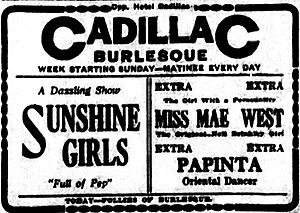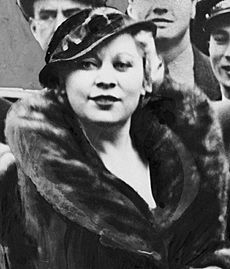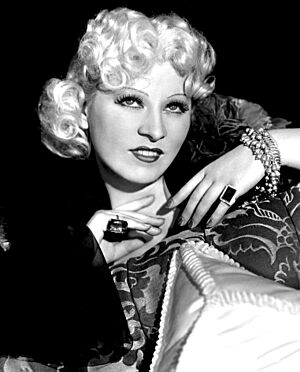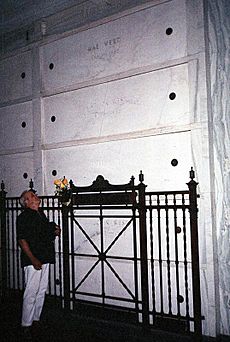Mae West facts for kids
Quick facts for kids
Mae West
|
|
|---|---|
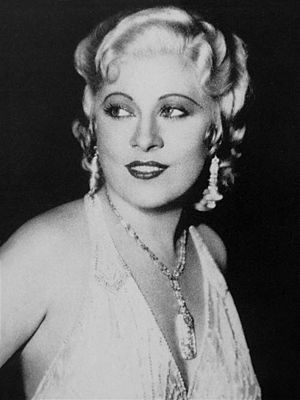
Publicity photo for Night After Night (1932)
|
|
| Born |
Mary Jane West
August 17, 1893 Brooklyn, New York, U.S.
|
| Died | November 22, 1980 (aged 87) Los Angeles, California, U.S.
|
| Resting place | Cypress Hills Cemetery |
| Occupation |
|
| Years active | 1907–1978 |
| Spouse(s) |
Frank Wallace
(m. 1911; div. 1943) |
| Partner(s) | Paul Novak (1954–1980; her death) |
| Signature | |
Mae West (born Mary Jane West; August 17, 1893 – November 22, 1980) was a famous American actress, writer, and singer. Her amazing career lasted for over 70 years! She started performing in live stage shows in New York City. Later, she moved to Hollywood to become a movie star.
After her movie career, she wrote books and plays. She also performed in Las Vegas and the United Kingdom. Mae West even recorded rock 'n roll albums. In 1999, the American Film Institute named her one of the 15 greatest female movie stars ever.
Contents
Early Life and Stage Career
Mary Jane West was born on August 17, 1893, in Brooklyn, New York. Her father, John Patrick West, was a prizefighter. He was known as "Battlin' Jack West." Her mother, Mathilde "Tillie" Delker, used to be a fashion model. Mae was the oldest child who lived past infancy. She had two younger siblings, Mildred and John.
Mae's family moved around Brooklyn and Queens when she was a child. She supposedly gave her first professional performance at a place called Neir's Social Hall.
How Mae West Started Performing
Mae West was only five years old when she first entertained a crowd at a church event. She started appearing in amateur shows at age seven. She often won prizes in local talent contests. At 14, in 1907, she began performing professionally in vaudeville. Vaudeville was a type of live stage show with many different acts.
Mae first used the stage name "Baby Mae." She tried out different characters, even pretending to be a male performer. Her unique way of walking was said to be inspired by famous male impersonators. At 18, in 1911, she appeared in her first Broadway show. A newspaper reviewer praised her "snappy way of singing and dancing."
In 1918, Mae West got a big break in a show called Sometime. She played a character named Mayme who danced the shimmy. Her picture even appeared on the sheet music for a popular song called "Ev'rybody Shimmies Now."
Becoming a Broadway Star
Mae West started writing her own plays. Her first starring role on Broadway was in a play she wrote, produced, and directed in 1926. Even though some critics didn't like it, many people bought tickets. City officials and some religious groups complained about the show. The theater was raided, and Mae West was arrested along with the cast.
She was charged with "corrupting the morals of youth." On April 19, 1927, she was sentenced to 10 days in jail. This event made her even more famous! The media called her the "bad girl" who became successful "wrong by wrong."
Between the late 1920s and early 1930s, Mae West kept writing plays. Her shows often caused controversy, which meant she stayed in the news. This also made sure her performances were always full of people. Her 1928 play Diamond Lil was a huge hit on Broadway. It was about a bold, smart lady from the 1890s. This play helped create Mae West's public image. It was so popular that she brought it back to the stage many times.
In 1931, Mae West starred in The Constant Sinner. It didn't do as well as Diamond Lil. But its daring nature and even negative reviews made her even more famous. After this play, Mae West decided to try something new. She accepted an offer to make a movie in Hollywood.
Movie Career and Challenges
In June 1932, Mae West signed a contract with Paramount Pictures. She was almost 40 years old, which was quite old to start a movie career, especially for women. But she managed to keep her real age a secret for a while. Her first movie was Night After Night (1932). She played a small role, but she was allowed to rewrite some of her character's lines.
In one scene, a girl says, "Goodness, what beautiful diamonds." Mae West's character replies, "Goodness had nothing to do with it, dearie." The main actor, George Raft, said, "She stole everything but the cameras."
Becoming a Movie Star
For her next movie, Mae West brought her "Diamond Lil" character to the screen. The movie was called She Done Him Wrong (1933). This film was one of Cary Grant's first big roles. Mae West said she saw him at the studio and insisted he be the main male actor. She claimed she told the director, "If he can talk, I'll take him!"
The movie was a huge success and helped save Paramount from going bankrupt. It made over $2 million, which would be like $140 million today! Paramount even named a building after her because of this.

Her next movie, I'm No Angel (1933), also starred Cary Grant. This was her most successful movie ever! After it came out, everyone was talking about Mae West. People mentioned her in songs, paintings, and even cartoons. A famous artist named Diego Rivera said, "West is the most wonderful machine for living I have ever known."
By 1933, Mae West was one of the biggest movie stars in the United States. By 1935, she was the highest-paid woman in the country. She was the second-highest paid person overall, after William Randolph Hearst.
Dealing with Censorship
In 1934, new rules for movies, called the Production Code, became very strict. This meant Mae West's movie scripts were changed a lot. Her next film, Belle of the Nineties (1934), was originally called It Ain't No Sin. But the censors made them change the title. Mae West insisted that the famous musician Duke Ellington and his orchestra be in the film. Their collaboration was a big hit.
Her next movie, Goin' to Town (1935), got mixed reviews. The censorship kept her from using her best lines. Her film Klondike Annie (1936) tried to talk about religion and hypocrisy, but it was hard with all the censorship. Some people called it her best work, but not everyone agreed. A powerful newspaper owner, William Randolph Hearst, even tried to stop people from seeing it. He asked, "Isn't it time Congress did something about the Mae West menace?"
Mae West said, "I was the first liberated woman, you know. No guy was going to get the best of me. That's what I wrote all my scripts about."
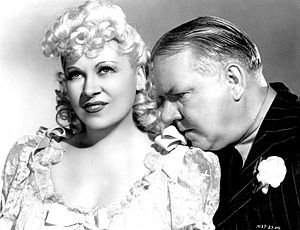
Around this time, Mae West also starred in Go West, Young Man (1936). This movie is seen as one of her weaker films because of all the censor's cuts. Her last film for Paramount was Every Day's a Holiday (1937).
Mae West, along with other big stars, was put on a list called "Box Office Poison." This meant that even though they were famous, their high salaries didn't always bring in enough ticket sales. This didn't stop producer David O. Selznick from offering her a role in Gone with the Wind. But Mae West turned it down. She felt the role was too small for her, and she would need to rewrite her lines to fit her style.
In 1939, Universal Studios asked Mae West to star in a movie with W. C. Fields. The movie was My Little Chickadee (1940). Even though Mae West and W. C. Fields didn't like each other and argued about the script, the movie was a big success. Religious leaders still criticized Mae West. They didn't like lines like, "When I'm caught between two evils, I generally like to take the one I never tried."
Mae West's next movie was The Heat's On (1943). She didn't want to do it at first. But her friend, director Gregory Ratoff, asked her for a personal favor. The movie didn't do well. Mae West was so upset by this and by years of fighting with the strict censorship rules that she didn't make another movie for 27 years! Instead, she focused on performing in nightclubs and Las Vegas. There, she was allowed to be herself.
Radio Appearances and Censorship
On December 12, 1937, Mae West appeared on a radio show called The Chase and Sanborn Hour. She flirted with Charlie McCarthy, a famous dummy, using her usual clever humor. This caused a big problem.
She also starred in a radio sketch about Adam and Eve in the Garden of Eden. The Federal Communications Commission (FCC) said the show was "far below even the minimum standard." NBC Radio blamed Mae West and banned her from their stations. She didn't perform on radio again for 12 years.
Later Career and Life
After her last movie in 1943, Mae West returned to performing live. She starred in a Broadway play called Catherine Was Great (1944). In this play, she made fun of the story of Catherine the Great. She surrounded herself with tall, muscular young actors. The play was very popular.
In 1949, Mae West brought her play Diamond Lil back to Broadway. The New York Times called her an "American Institution—as beloved and indestructible as Donald Duck." In the 1950s, she had her own show in Las Vegas at the Sahara Hotel. She sang while surrounded by bodybuilders. The show was a huge hit! She said, "Men come to see me, but I also give the women something to see: wall to wall men!"
Mae West was offered the role of Norma Desmond in the 1950 film Sunset Boulevard. But she turned it down. She felt the movie's sad theme didn't fit her style of comedy, which was always about making people feel good. She also turned down roles in movies with Elvis Presley and Frank Sinatra.
Television and Music
On March 26, 1958, Mae West appeared live on the Academy Awards show. She sang "Baby, It's Cold Outside" with Rock Hudson and got a standing ovation. In 1959, she wrote her autobiography, Goodness Had Nothing to Do With It, which became a best-seller. She also appeared on TV shows like The Dean Martin Variety Show and Mister Ed.
Mae West started recording music in the 1930s. In 1955, she released her first album, The Fabulous Mae West. In 1966, she recorded Way Out West, her first rock-and-roll album. Her second rock-and-roll album, Great Balls of Fire, came out in 1972. It included songs by famous bands like The Doors.
Final Years and Legacy
After not making movies for 27 years, Mae West appeared in Myra Breckinridge (1970). She was a smart investor and used her money to buy land in Los Angeles. This meant she could afford to do whatever she wanted.

In 1976, she began work on her last film, Sextette (1978). She was 84 years old, and her eyesight was failing. But she was determined to finish the movie. She even had her lines whispered to her through a speaker hidden in her hair! Time magazine wrote an article about her called "At 84, Mae West Is Still Mae West."
Sextette didn't do well with critics or at the box office. But it had a very interesting cast, including some of her first co-stars, like George Raft. It also featured pop stars like Ringo Starr from The Beatles and Alice Cooper.
Mae West has a star on the Hollywood Walk of Fame for her contributions to movies. She is also in the American Theater Hall of Fame for her work on stage.
Public Image
Mae West was known for her "voluptuous figure." Her famous look included a long, tight dress with a low neckline. It often had a fishtail train and feathers.
Personal Life
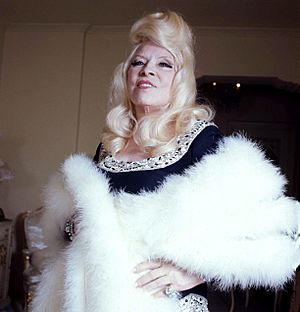
Mae West secretly married Frank Wallace, a fellow performer, in 1911 when she was 17. She kept it a secret for many years. They never lived together as husband and wife. They officially divorced in 1943.
She had a close relationship with her manager, James Timony, for many years. They lived in the same building and supported each other. Mae West was also close to her family. She helped her sister, brother, and father by providing them with homes and jobs in Hollywood.
One of her boyfriends was a boxer named William Jones, also known as Gorilla Jones. When her apartment building wouldn't let him in because he was African American, Mae West bought the building and lifted the ban!
Later in life, she became romantically involved with Paul Novak. He was a bodybuilder from her Las Vegas show and 30 years younger than her. He moved in with her, and they stayed together until her death in 1980. Paul Novak once said, "I believe I was put on this Earth to take care of Mae West."
Mae West sometimes talked about "Mae West" as the famous character she had created.
Death
In August 1980, Mae West fell out of bed. She couldn't speak and was taken to the hospital. Doctors found that she had suffered a stroke. She passed away on November 22, 1980, at 87 years old.
A private service was held for her. She was buried in the family mausoleum at Cypress Hills Cemetery in Brooklyn. Her mother, father, and brother were already buried there. Her younger sister was buried there less than two years after Mae's death.
Broadway Stage Performances
| Date | Production | Role | Notes | Ref. |
|---|---|---|---|---|
| September 22, 1911 – September 30, 1911 | A La Broadway | Maggie O'Hara | ||
| November 20, 1911 – February 24, 1912 | Vera Violetta | West left the show during previews | ||
| April 11, 1912 – September 7, 1912 | A Winsome Widow | Le Petite Daffy | West left show after opening night | |
| October 4, 1918 – June 1919 | Sometime | Mayme Dean | ||
| August 17, 1921 – September 10, 1921 | The Mimic World of 1921 | |||
| January 1927 | The Drag | Closed during out-of-town tryouts (Bridgeport, Connecticut) credited only as writer |
||
| November 1927 | The Wicked Age | Evelyn ("Babe") Carson | ||
| April 9, 1928 – September 1928 | Diamond Lil | Diamond Lil | ||
| October 1, 1928 – October 2, 1928 | The Pleasure Man | Credited only as writer | ||
| September 14, 1931 – November 1931 | The Constant Sinner | Babe Gordon | ||
| August 2, 1944 – January 13, 1945 | Catherine Was Great | Catherine II | ||
| 1945–46 | Come on Up | Tour | ||
| September 1947 – May 1948 | Diamond Lil | Diamond Lil | (Revival) United Kingdom | |
| February 5, 1949 – February 26, 1949 | Diamond Lil | Diamond Lil | (Second revival) until West broke her ankle on the latter date The play resumed as a "return engagement" |
|
| September 7, 1949 – January 21, 1950 | Diamond Lil | Diamond Lil | (Second revival) as "return engagement" | |
| September 14, 1951 – November 10, 1951 | Diamond Lil | Diamond Lil | (Third Revival) | |
| July 7, 1961 – closing date unknown | Sextette | Edgewater Beach Playhouse |
| Year | Title | Notes | Ref. |
|---|---|---|---|
| 1921 | The Ruby Ring | Vaudeville playlet | |
| 1930 | Frisco Kate | Not produced at the time, later became the 1936 film Klondike Annie | |
| 1933 | Loose Women | Performed in 1935 under title Ladies By Request | |
| 1936 | Clean Beds | Sold her idea to George S. George, who made an unsuccessful Broadway play from it |
Filmography
| Year | Film | Role | Writer(s) | Co-stars | Director | Studio |
|---|---|---|---|---|---|---|
| 1932 | Night After Night | Maudie Triplett | Story: Louis Bromfield Screenplay: Vincent Lawrence Continuity: Kathryn Scola Additional dialogue (uncredited): Mae West |
George Raft Constance Cummings Wynne Gibson |
Archie Mayo | Paramount Pictures |
| 1933 | She Done Him Wrong | Lady Lou | Screenplay: Harvey F. Thew and John Bright Based on the play Diamond Lil by Mae West |
Cary Grant Owen Moore Gilbert Roland |
Lowell Sherman | |
| I'm No Angel | Tira | Story, Screenplay and All Dialogue: Mae West Suggestions: Lowell Brentano Continuity: Harlan Thompson |
Cary Grant Gregory Ratoff Edward Arnold |
Wesley Ruggles | ||
| 1934 | Belle of the Nineties | Ruby Carter | Mae West | Roger Pryor Johnny Mack Brown Katherine DeMille |
Leo McCarey | |
| 1935 | Goin' to Town | Cleo Borden | Screenplay: Mae West Story: Marion Morgan and George B. Dowell |
Paul Cavanagh Gilbert Emery Marjorie Gateson |
Alexander Hall | |
| 1936 | Klondike Annie | The Frisco Doll Rose Carlton Sister Annie Alden |
Screenplay: Mae West Story: Marion Morgan and George B. Dowell And material suggested by Frank Mitchell Dazey |
Victor McLaglen Phillip Reed Helen Jerome Eddy |
Raoul Walsh | |
| Go West, Young Man | Mavis Arden | Screenplay: Mae West Based on the play Personal Appearance by Lawrence Riley |
Warren William Randolph Scott Alice Brady |
Henry Hathaway | ||
| 1937 | Every Day's a Holiday | Peaches O'Day | Mae West | Edmund Lowe Charles Butterworth Charles Winninger |
A. Edward Sutherland | |
| 1940 | My Little Chickadee | Flower Belle Lee | Mae West and W. C. Fields | W. C. Fields Joseph Calleia Dick Foran |
Edward F. Cline | Universal Pictures |
| 1943 | The Heat's On | Fay Lawrence | Fitzroy Davis & George S. George and Fred Schiller | Victor Moore William Gaxton Lester Allen |
Gregory Ratoff | Columbia Pictures |
| 1970 | Myra Breckinridge | Leticia Van Allen | Screenplay: Michael Sarne and David Giler Based on the novel by Gore Vidal |
Raquel Welch John Huston Farrah Fawcett |
Michael Sarne | 20th Century Fox |
| 1978 | Sextette | Marlo Manners Lady Barrington |
Screenplay: Herbert Baker Based on the play by Mae West |
Timothy Dalton Dom DeLuise Tony Curtis |
Ken Hughes | Crown International Pictures |
Discography
Albums:
- 1956: The Fabulous Mae West; Decca D/DL-79016 (several reissues up to 2006)
- 1960: W.C. Fields His Only Recording Plus 8 Songs by Mae West; Proscenium PR 22
- 1966: Way Out West; Tower T/ST-5028
- 1966: Wild Christmas; Dragonet LPDG-48
- 1970: The Original Voice Tracks from Her Greatest Movies; Decca D/DL-791/76
- 1970: Mae West & W.C. Fields Side by Side; Harmony HS 11374/HS 11405
- 1972: Great Balls of Fire; MGM SE 4869
- 1974: Original Radio Broadcasts; Mark 56 Records 643
- 1996: I'm No Angel; Jasmine CD 04980 102
- 2006: The Fabulous: Rev-Ola CR Rev 181
At least 21 singles (78 rpm and 45 rpm) were released from 1933 to 1973.
Images for kids
See also
 In Spanish: Mae West para niños
In Spanish: Mae West para niños


